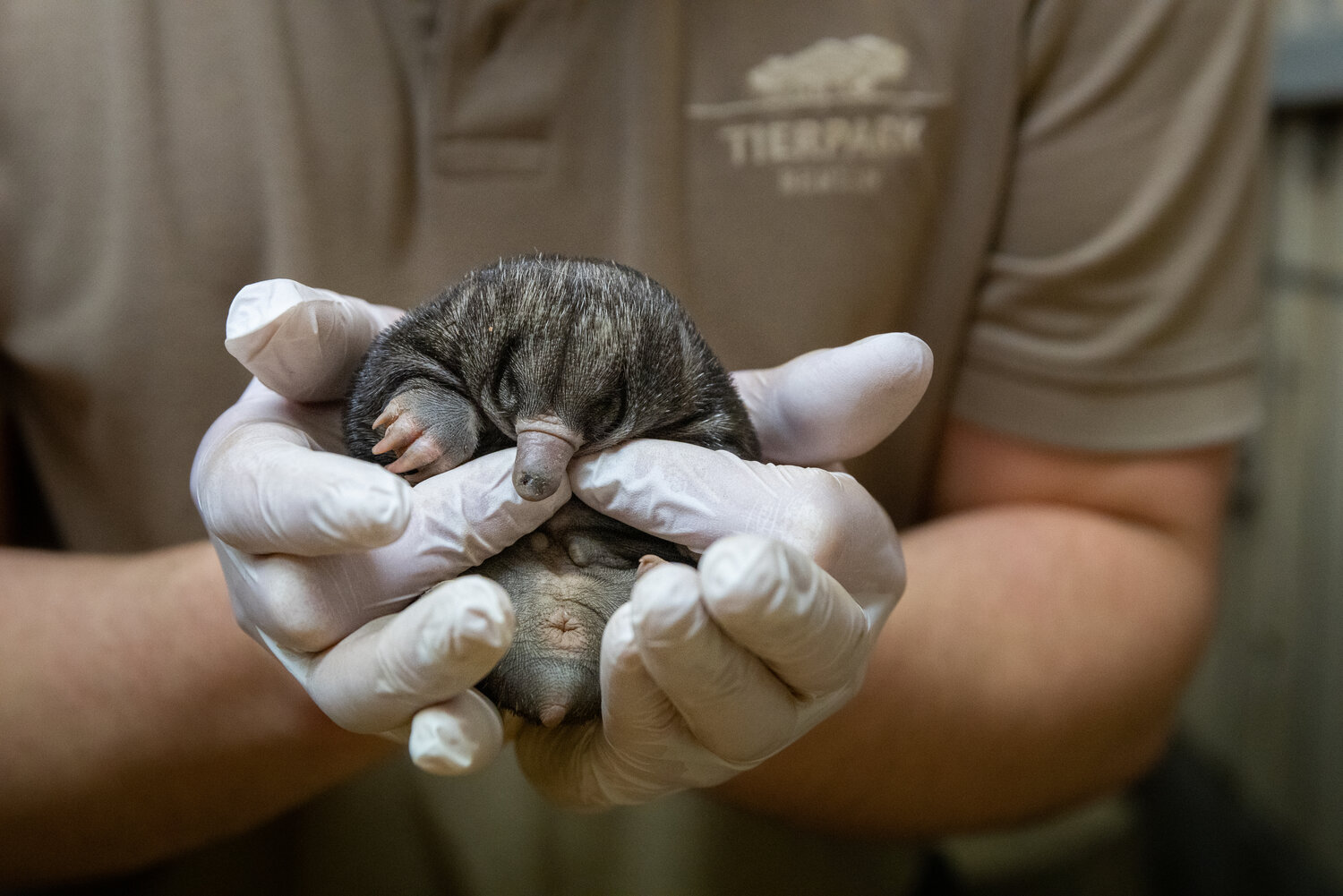A curious mammal with spines and a pouch has now laid a very special Easter egg: A New Guinea short-beaked echidna has hatched from this egg in Berlin for the first time in 115 years. In 1908, the world's first echidna was born outside its natural habitat at Berlin Zoo. More than a century later, Tierpark Berlin was able to build on this historic success.
On 25 February, wildlife care specialist Andrea Fleischer discovered a puggle among the curious Australian mammals for the first time in the history of Tierpark Berlin and was extremely excited. "In my 45 years of work, I've experienced quite a few things, but this was a very special moment," she reports euphorically. The three short-beaked echidnas Tufi (12 years old), Bruno (12) and Harapan (9) have been living in the zoo for about ten years. "We have been hoping for offspring for a long time, have been in close contact with colleagues from other zoos all over the world and have always adapted the keeping conditions according to the latest findings. Now the conditions seem to have been perfect. Tufi has chosen Harapan as the father of her first offspring," says Fleischer. There are only a few echidnas in human care. Of the subspecies of the New Guinea short-beaked echidna, there are only 33 animals worldwide - that they reproduce is all the rarer. Every offspring is a minor sensation in expert circles and in Germany, breeding has only succeeded twice before.
Living witnesses of evolution
Spines like a hedgehog, a beak like a bird, a pouch like a kangaroo and powerful claws like a mole - what sounds like a truly fantastic beast that seems to have sprung from Joanne K. Rowling's imagination actually exists: the short-beaked echidna is an unusual animal from head to tail. Electroreceptors on its tube-shaped nose seem to help it to find its food. Together with the platypus, echidnas are the only mammals in the world that lay eggs. After a ritual - known as the "echidna love train" - in which interested males follow their lady of the heart in a kind of mating polonaise, an egg about the size of a grape is stowed away by the female in a temporary belly pocket until a still naked, gummy bear-sized youngster hatches from it 10 days later. After about two months, the young puggle develops its first spines and the mother hides her pricking mini echidna in an underground burrow, where she regularly visits it to suckle. Since echidnas, unlike all other mammals, do not have teats, the young suck milk from milk fields in the mother's fur. Echidnas, like platypuses, have only one body orifice for faeces, urine and egg-laying. This gave this group of animals the name “monotremes”. "The monotremes are a very primitive group of mammals that already existed in the time of the dinosaurs and combine characteristics of reptiles and mammals," explains Zoo and Tierpark Director Dr Andreas Knieriem and adds: "With this sensational offspring, we have gained a lively contemporary witness of evolution in addition to the already extinct dinosaurs that are now on display in Tierpark Berlin.” After the three echidnas Harapan, Bruno and Tufi had to leave their former home in the pachyderm house, they found temporary accommodation in a rear area of the Tierpark. The animals are currently not visible to zoo visitors. However, one of the two males will soon find a new home in the nocturnal house of Zoo Berlin.
Zoos create valuable knowledge
"Knowledge about animals is the basis for successful conservation breeding programmes," explains zoological director Christian Kern. "We can often only acquire this knowledge by observing animals in human care. The fact that zoos have now succeeded in learning more about these animals and their reproductive behaviour through scientific studies and intensive international exchange with specialist colleagues is a great success. For the critically endangered relatives, the Western long-beaked echidna, this knowledge could become vital," he continues. Conservation breeding programmes play an important role in saving endangered species. Coordinated breeding in zoological institutions has already saved Przewalski's horses and European bison, which were once extinct in their natural habitat. For many other endangered species, such as the Vietnamese pheasant, breeding in human care and reintroducing them into their natural habitat is the last hope.
Interesting facts about the short-beaked hedgehog
Short-beaked echidnas...
... live in Australia, Tasmania and New Guinea.
...feed primarily on ants, termites and insects in their natural habitat.
...can live up to 45 years.
...were first described by western science in 1792. It was not until 1887 that researchers in Frankfurt and Sydney simultaneously discovered that echidnas lay eggs.
...can swim.
...owe their scientific name "Tachyglossus aculeatus" to their long, fast tongue - which has a record-breaking frequency of 100 "licks" per minute ("Tachyglossus" = "fast tongue").
